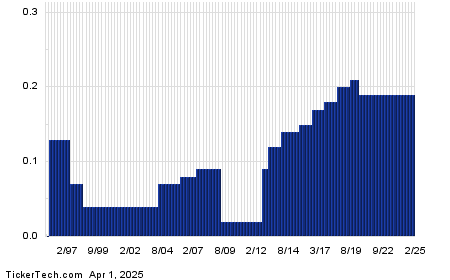Coffee Prices Dip Amid Increased Supply and Favorable Weather in Brazil
March Arabica and Robusta Coffee Prices Decline
March arabica coffee (KCH25) closed down -8.20 (-2.51%) on Friday, while March ICE robusta coffee (RMH25) fell -88 (-1.74%).
Brazil’s Rainfall Eases Drought Concerns
On Friday, coffee prices posted moderate losses amid easing drought worries following substantial rain in Brazil. A report from Somar Meteorologia indicated that Brazil’s main arabica coffee-growing region of Minas Gerais received 102.8 mm of rain last week, 182% of the historical average.
Robusta Market Influenced by Vietnam’s Weather
Robusta coffee prices hit a two-week high on Thursday due to fears that persistent heavy rainfall in Vietnam would further hinder the country’s coffee harvest. According to the Vietnam General Department of Customs, coffee exports for November plummeted -47% year-on-year to 63,019 metric tons, and January-November exports fell -14% year-on-year to 1.22 million metric tons. Flooding in Vietnam has already impacted the coffee fields, delaying the robusta coffee harvest. As the world’s largest robusta producer, Vietnam’s harvest is closely watched.
Increasing Inventories Weighing on Coffee Prices
The rise in coffee inventories adds pressure on prices. As of Monday, ICE-monitored arabica coffee stocks reached a two-and-a-half-year high of 991,080 bags, while robusta inventories rose to a two-and-a-half-month high of 4,355 lots on Tuesday.
Currency Fluctuations Impacting Brazilian Exports
The weakness of the Brazilian real (^USDBRL) is another factor working against coffee prices. The real is hovering just above its recent record low against the dollar, which encourages Brazilian coffee producers to increase exports.
Previous Price Rally Sparks from Projection of Smaller Crop
Last month, coffee prices surged due to expectations of a smaller crop in Brazil. March arabica prices reached a contract high, while December’s nearest-futures contract (Z24) set a record high. A crop tour led Volcafe to reduce its estimate for Brazil’s arabica coffee production for 2025/26 to 34.4 million bags, down by about 11 million bags from September’s estimates. This forecast suggests a global arabica deficit of 8.5 million bags for the 2025/26 season, surpassing the 5.5 million bags deficit anticipated for 2024/25.
USDA Report Offers Mixed Signals for Future Prices
The USDA’s biannual report from December 18 presented a mixed outlook. The Foreign Agriculture Service (FAS) estimated a 4% global coffee production increase for 2024/25, projecting it will rise to 174.855 million bags, with a 1.5% increase in arabica and a 7.5% increase in robusta production. Ending stocks for 2024/25 are expected to drop -6.6% to 20.867 million bags, the lowest in 24 years. Meanwhile, previous estimates of Brazil’s 2024/25 coffee output were revised down to 66.4 million metric tons from earlier forecasts of 69.9 million metric tons.
Weather Challenges Continue for Coffee Production
The adverse effects of irregular El Niño weather patterns this year might have lasting impacts on coffee crops in South and Central America. Since April, rainfall in Brazil has remained below average, damaging coffee trees during the flowering stage and diminishing the prospects of the 2025/26 arabica crop. Brazil has been experiencing its driest weather since 1981, according to Cemaden, a natural disaster monitoring center. Similarly, Colombia, the world’s second-largest arabica producer, is slowly recuperating from El Niño-induced drought.
Robusta Production Declines Amid Drought
Robusta prices are supported by a reduction in production. Vietnam’s output for the 2023/24 crop year fell by -20% to 1.472 million metric tons, marking the smallest yield in four years. The USDA FAS projected that robusta production for 2024/25 would slightly decline to 27.9 million bags from 28 million bags in 2023/24. However, the Vietnam Coffee and Cocoa Association revised its estimate for 2024/25 upward to 28 million bags from an earlier October prediction of 27 million bags.
Increase in Global Coffee Exports Challenges Prices
Increased global coffee exports present additional challenges for pricing. The International Coffee Organization (ICO) reported that global coffee exports in October rose by +15.1% year-on-year to 11.13 million bags, while exports for the 2023/24 season increased by +11.7% year-on-year to 137.27 million bags. Additionally, Brazilian coffee exports grew by +2.7% year-on-year to 4.29 million bags, leading to record coffee exports of 47.3 million bags for the 2023/24 season.
Production Surplus Reported Amid Rising Consumption
In a bearish development, the ICO announced that 2023/24 global coffee production climbed +5.8% year-on-year to a record 178 million bags, driven by an exceptional off-biennial crop year. Global coffee consumption also increased by +2.2% year-on-year to a record 177 million bags, resulting in a surplus of 1 million bags.
On the date of publication, Rich Asplund did not have (either directly or indirectly) positions in any of the securities mentioned in this article. All information and data in this article is solely for informational purposes. For more information please view the Barchart Disclosure Policy here.
The views and opinions expressed herein are the views and opinions of the author and do not necessarily reflect those of Nasdaq, Inc.


